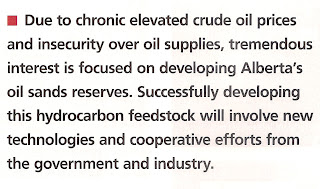 |
| Oil Industry |
Oil and gas companies are facing increasing demands for their products and, at the same time, need to meet those demands in an environmentally responsible way. The reality of accelerating demand is one of the three hard truths that Jeroen van der Veer, Shell Group chief executive, has recently stated will generate turbulence in the global energy system in the decades ahead.
► More demand. By 2050, some analysts believe that energy usage may be twice as high as it is today, or even greater. The main causes for greater demand will be global population growth— from six billion to more than nine billion people—and higher levels of prosperity.
► Access to energy resources. The second hard truth is that the growth rate in supplies of "easy oil," i.e., conventional oil and natural gas that are simple to extract, will struggle to keep up with accelerating demand. Unconventional resources, such as oil shale and oil sands, may provide a solution. However, less than half of these hydrocarbon resources can be recovered with existing technology.
► Carbon footprint. The third truth is that increased coal use will cause higher carbon dioxide (C02) emissions, possibly to levels deemed unacceptable. The International Energy Agency predicts that coal use could grow by approximately 60% over
the next 20 years. China and India will continue to exploit their domestic coal reserves to be less dependent on oil and gas imports, as will the US, which now generates more than half its electricity with coal.
The future. Mr. van der Veer emphasized the importance of energy efficiency and recommended that we should aim to become twice as efficient in our energy use by mid-century. He also believes that we should broaden the global energy mix as quickly as we can by including more unconventional oil and gas, alternative energy sources, coal and nuclear energy.
For instance, the Shell Group (Shell) believes that blending of synthetic fuels—such as those derived from biomass, gas or coal—will become more frequent. These sources can also be used to produce other fuels such as hydrogen for fuel cells. Shell is developing several alternative energy sources; it is the largest distributor of first-generation biofuels and one of the largest investors in wind energy. Shell is also investing in new technology such as second-generation biofuels, thin-film solar cells and hydrogen cells.
Shell is one of several organizations that has developed low-temperature Fischer—Tropsch gas-to-liquids (GTL) technology for producing synthetic fuels. The latest GTL process uses a more active and selective catalyst than earlier processes, and new catalyst systems enable producing a range of finely tailored liquid fuels in a fully commercialized system. GTL fuels can be used in conventional diesel engines and provide significantly lower emissions of local pollutants such as particulates, carbon monoxide, hydrocarbons and nitrogen oxides, even when compared with ultra-low-sulfur diesel.
Shell is committed to reducing the carbon footprint of its refineries. The Shell Global Solutions carbon and energy management program is designed to help improve energy efficiency in large, energy-intensive operations. The program combines structured management processes and monitoring tools linked to real-time plant data systems to continuously reduce energy costs, bottlenecks and emission levels.
New solutions. Applying technology to accelerate C02 mineralization is another solution that may help cut emissions. Mineralization, which occurs naturally over millions of years, involves chemical reactions between CO2 and common silicates to produce silica and stable carbonates. Scientists at Shell Global Solutions have discovered a way of accelerating this reaction—from millennia down to minutes. This makes an industrial process technically feasible.
However, as Bill Spence, Shell's vice president C02, has recently commented, the carbon-emissions challenge cannot be met by one company or the energy industry alone. There will be a need for public and private partnerships and a strong policy framework in creating carbon capture and storage infrastructure. The period post-2012, when the current Kyoto protocol expires, will be critical in determining how the world responds to these opportunities.

